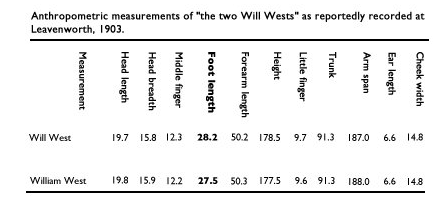A Strange case of Will West: Turning Point of Personal identification from Anthropology to Fingerprint Analysis
 |
| Photo from the Collection of the National Law Enforcement Museum, Washington, D.C. (1960). |
At the turn of the 20th century, investigators had tinkered with fingerprinting, but the technique was not widely used. The FBI Investigators relied on the much-trusted Bertillon system, which "measured dozens of features of a criminal's face and body and recorded the series of precise numbers on a large card along with a photograph.
That system, which had been used by investigators following its initial implementation in 1882 in Paris, met its match -- so to speak -- when convicted criminal Will West was marched into Leavenworth federal prison in Kansas in 1903.
"From the Bertillon measurements thus obtained, [the record keeper] went to the file, and returned with the card the measurements called for, properly filled out...and bearing the name, “William West.” This card was shown to the prisoner, who grinned in amazement, and said, “That’s my picture, but I don’t know where you got it, for I know I have never been here before.” The record clerk turned the card over, and read the particulars there given, including the statements that this man was already a prisoner at the same institution, having been committed to a life sentence on September 9, 1901, for the crime of murder.
- Authors Harris Hawthorne Wilder and Bert Wentworth (1918)
Although the Bertillon measurements of the Wests were nearly indistinguishable, the two men’s fingerprints revealed profound differences, exhibiting fingerprinting's validity. According to the FBI, the story goes like this: The admissions clerk at the prison thought he recognized West and asked if he'd ever been incarcerated there. West twice replied that he certainly hadn't. The clerk took West's Bertillon measurements, went to the files and came back with a card for "William" West, thinking he had his man.
"Despite the similarity of appearance, of names, and of their Bertillon measurements, the fingerprints of Will West and William West were completely different: an Inside Whorl of 11 ridges (Will) vs. an Invaded Loop with 18 ridges (William)." - NY Times, "Whats in a Name?" (2012)
 |
| Photo and caption from New York Times 2012 article "Whats in a Name?" |
The clerk, convinced that she was correct, collected Mr. West’s Bertillon measurements and dug through the archives of inmates. Eerily, she pulled out a file that undoubtedly was the face of the man standing in front of her.
 |
| Photo and caption from Michael Lynch's 2003 article "God's Signature: DNA, profiling, the new gold standard in forensic science" in the science journal Endeavour. |
However, he was telling the truth. Mr. West had never been to Leavenworth and was naturally perturbed. How had his photo ended up in the files of the penitentiary? As it turned out, there was another inmate with the exact measurements as Mr. West who was already there serving a life sentence. If that wasn’t strange enough, his doppelgänger was also named William West.
The two men were not related in any way, and law enforcement quickly realized that a more reliable method of identification was necessary. The case of Will and William West changed the face of forensics. Fingerprinting soon became the standard method for identifying criminals.
Because of these two men, you never have to worry about going to prison simply for sharing the same face and physical characteristics of another known criminal. Luckily for us all, our unique fingerprints will never allow for another case of mistaken identity.
Photo Credits: Weebly.com

Comments
Post a Comment